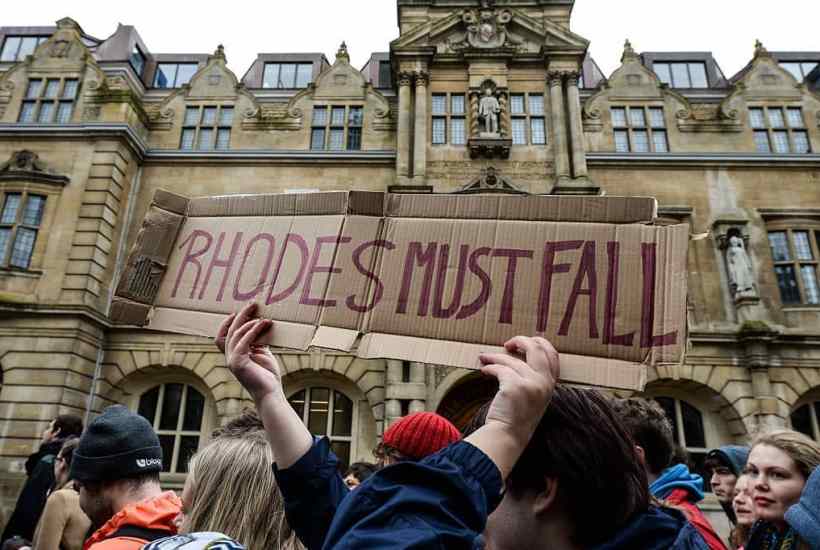On 12 October this year, Columbus Day, a statue of the Italian in Belgrave Square was vandalised by activists from Extinction Rebellion who described Columbus as ‘father of the slave trade’. Entirely ignorant of his life and ambitions, Columbus’s critics frequently turn to the searing denunciations of Bartolomé de Las Casas who excoriated the Spanish policy towards the native peoples of America. They are unaware that Las Casas was a great admirer of Columbus, and that this friar, who felt such pity for the native Americans, actively recommended the mass importation of black African slaves as an alternative labour source.
In the same week as the Extinction Rebellion stunt a new plaque was unveiled at Oriel College, below a statue of Cecil Rhodes. The sign described Rhodes as a ‘committed British colonialist’ who exploited the people of southern Africa. No mention was made of the Rhodes scholarship which he founded.
Both episodes highlight key problems with the now popular policy of ‘retain and explain’ – the idea that statues should be kept but given plaques which contextualise their legacy. ‘Retain and explain’ is a memorable catchphrase and has been a helpful way for public bodies to prevent statues being pulled down. Yet the problem is explaining how to explain. We can agree that monuments and objects should not be hidden away from their current position in public squares, museums or universities. How they came to be where they are is part not just of their individual history, as objects, but of the history of this country. Statues speak about social and political priorities at the time they were created and, even when myths about people immortalised in bronze have been dispelled, those myths have strong historical interest of their own. But what needs to be said on plaques accompanying a disputed monument?

Simon de Montfort is commemorated by a statue outside the parliament he supposedly created. The story of how parliament came into being is much more complicated; and he was a ruthless man, intolerant even by the standards of his time (encouraging a pogrom against the Jews of London, for instance). Oliver Cromwell, too, stands outside the parliament without which he proved happy to rule, as he did violently in Ireland. But both men played a crucial role in the history of the British Isles. ‘Explanation’ therefore requires consideration of a career in all its aspects, not concentration on what would now be seen as negative.
Often we can point to what would now be considered blemishes in otherwise notable careers, for instance attitudes that were shed later in life. If Gladstone did indeed sympathise with slave owners as a young man, that was not his opinion when he dominated British politics.
Arguments rage about whether accusations against figures in the past are soundly based in the evidence. There are different points of view about Palmerston and the Potato Famine or Churchill and the Bengal Famine. ‘Explanation’ requires the presentation of arguments from both sides.
Increasingly, though, people disagree with this approach. They argue that ‘there is no cancel culture so there is nothing to discuss.’ The argument that cancel culture is a figment of the right-wing imagination is the latest tactical move by those who would like to shut down debate. Yet that argument is easy to disprove. Crowds gathered outside Oriel College to demand the removal of a statue so high up that few people noticed it. Papers flew back and forth as the Fellows of Gonville and Caius College, Cambridge argued about a window celebrating the achievements of the geneticist Sir Ronald Fisher, accused of fostering eugenics. By all accounts the Fellows of All Souls expended much of their impressive brainpower arguing for and against the retention of the name ‘Codrington Library’, newly conscious of Codrington’s profits from Caribbean sugar.
The debate about the moral behaviour of people in the past is, then, very much alive. Historians should not spend their time weighing up past actions according to modern standards of morality. That does not mean it is unacceptable to describe the Atlantic slave trade or the Holocaust as horrific. Here there is general consensus. But there is absolutely no consensus about linking Nelson to the slave trade or, more generally, about the notion that capitalism is based on racism, whatever these terms are intended to mean. ‘Explanation’ therefore involves a resistance to fashionable group-think and a return to the hard evidence.
Producing a balanced account of a career in a few dozen words for a plaque that will go on public display is extremely difficult. That is why those in charge of ‘retain and explain’ should avoid controversy and stick to plain facts. Nor should these plaques be displayed solely next to controversial statues and monuments; that would single them out as contested sites, and often increase the clamour for their removal. The Haberdashers’ Company has agreed to expound the career of their controversial benefactor Robert Aske under his portrait in its livery hall; but all the other portraits will also have labels. That is the right decision.
Wokery may leave us with few uncontroversial sites: John Betjeman at St Pancras, perhaps; but even the statue of Paddington Bear at Paddington Station deserves an explanatory plaque to enlighten all those who are unfortunate enough not to have encountered a Peruvian bear on the streets of London.
Got something to add? Join the discussion and comment below.
Get 10 issues for just $10
Subscribe to The Spectator Australia today for the next 10 magazine issues, plus full online access, for just $10.




















Comments
Don't miss out
Join the conversation with other Spectator Australia readers. Subscribe to leave a comment.
SUBSCRIBEAlready a subscriber? Log in